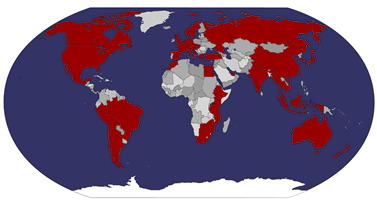So, back to my flight, Kathmandu to Chengdu in China via Lhasa.
Checked in and in seat 1A, I admire my boarding card, upon which they’ve written in blue biro “Business Class”. I ask if there’s a lounge available and they laugh at me. Hmmm.

Classy
I want to call Raju but there’s no normal phone at the airport. I go through immigration, and into the waiting area before security. The tip here is to stay here as long as possible, as past security there’s one tiny room playing Nepali TV with a terrible toilet. Here there is plenty of space, BBC World playing, and tolerable toilets.
Eventually I go through, and have half an hour in the packed gate before we get on. The new airbus is pleasantly decked out, and I’ve chosen (by accident) the right side to sit on (left), as the plane flies along the southern side of the Himalaya before “doing a left” just past Everest and turning up to Tibet. Great views! There’s blanket cloud through which Peak XV (as it was first named by the British surveyors) pokes.

Everest on the left

After Everest, we whizz across the Tibetan plateau, very barren, a scrubby yellow colour, mostly without snow except high ridges and peaks. No moisture from the Bay of Bengal clears the Himalayas and so despite getting very cold there is rarely any snow.

Plateau
An occasionally turquoise blue lake breaks the monotonous plain. LP makes the point that if you take the train from Lhasa to China, the peaks you pass don’t look that impressive, as despite being world-beating in height, they start from such an altitude that they appear to be mere hills.

Just a dusting of snow

A tasty pie for luncheon
Towns seems small as we fly overhead, and probably are.

Town?

Looking back over the wing towards the Himalaya
Just a brief stop

The Dear Leader
We come into land at Lhasa Gongga Airport, which I read in LP is either 95 or 65km away from Lhasa City, depending on which page you believe. Either way, no Potala Palace. I ask the stewardess if we’ll see it on the way to Chengdu, she says probably not. Damn!

Lhasa!
From what I gather, that’s the only thing that is still Tibetan in Occupied Tibet, if I’d seen that from the air I could probably say I’ve ticked the country off, at least until China end their occupation. Well at least I step off and am on Tibetan soil.
The airport is flashy, new, but quiet, apart from the loud rabble noise from the Chinese passengers, which is something I’ll have to get used to going by Mei’s blog.

I’m confused about how this transit is going to work. I don’t have a permit so presumably can’t come out, but do I need to collect my bags as we’re effectively switching to be a domestic flight? It’s a bit chaotic, as we come out and a lady holds up a sign saying Chengdu, she asks us to wait beside her, at the top of the escalator that all the other passengers use. Of course all the transit passengers block the way for those stopping here – they haven’t thought this out very well.

Time check
Immigration is a breeze. I want to take photos but am not sure whether that’s wise. We’re led down and back through security, where someone swaps our previous boarding card for a new one from a pile. He gives me 2D. Fairly sure that it isn’t, I ask if that is a window seat. He says yes it is. It isn’t.

Locked

Back on
Anyway, I manage to move on the plane, and end up across the row from where I was before, next to a British chap who works in Seoul and has been holidaying in Tibet. Apparently his (Chinese) girlfriend registered herself as a guide so they could do the trip.
Let me just explain what I’ve learnt about Tibetan entry requirements from Nepal (they’re different if you come from China). There’s so much information on the web, much of it rubbish. Currently, to go to Tibet you need a Permit. This is issued by the Chinese Embassy only to Tour Operators for people booked into a tour. You cannot travel to Tibet alone. Or rather you can, but you have to go through the farce of having a pretend tour that you have to pay for.
For a tour, you also need a Group Visa. If you plan to do something else after the tour, like travel to China, you need a Group Visa just for you, as you basically can’t split off from one once in Tibet. This all has to be done through agencies. There is talk of this being relaxed, although a Hungarian couple who I met in Beijing found everything suddenly tightened up because of a small protest that had occurred. So it’s one of those things where you can never be sure until you’re there!
Free Tibet!
So what is the Tibetan China issue? It seems to be quite polarising – China with one view and the rest of the world with the other, but that’s never going to get anywhere in diplomacy – the Chinese have a concept of avoiding “losing face”, i.e. they can never be seen to lose, hence they will never willingly free Tibet, or Taiwan. Tibet was an independent nation from the 7th century AD, when the Tibetan armies expanded their grip on the region, taking Nepal and parts of China, including Yunnan, Kashgar and Xian. Ironically the excuse for China invading Tibet is that it was once part of the Mongol Empire, but using the same logic Tibet could claim large swathes of China!
So in 1950, China invaded Tibet, describing it as a “Liberation”, much in the same way that the refugees in Darfur are currently being liberated, as are the monks in Burma by the military junta under Than Schwe. In 1959 there was a full-scale revolt which was crushed by the Chinese PLA Army. Amid rumours that the Chinese were going to kidnap the Dalai Lama, he fled to India, as did hundreds of thousands of Tibetans. Indeed Ladakh and Darjeeling are probably now more Tibetan than Tibet, given the ongoing “cultural genocide” (the Dalai Lama’s words).
China ruled Tibet with a heavy hand after the uprising, and they suffered more than most parts of China in the Cultural Revolution and Great Leap Forwards. It is claimed that 1.2 million Tibetans have been killed by China in the course of their invasion and ongoing occupation. For a country with 2.7 million people, that’s not bad going. Of course they’re all being replaced by Han Chinese, now being shipped in on the new train in ever greater numbers.
Last week the Dalai Lama was welcomed in the US, angering China. This was a rare showing of spine on the part of the West though – in general China is not confronted because of countries not wanting to upset trade relations. There is hope that as the spotlight turns on China in the run up to the 2008 Olympics in Beijing, that pressure will be put on China to change their approach to Tibet. The Dalai Lama has given up asking for full independence, he now pushes for autonomy within China, perhaps making Tibet a SAR (Special Administrative Region), like HK or Macau. Incidentally, just owning a photo of the Dalai Lama is an imprisonable offence in Tibet. I must admit that I left my Free Tibet t-shirts at home, but I’ll happily protest outside the Chinese Embassy in Portland Place when back in the UK.
Beijing 2008: Game’s Over, Free Tibet!

Fighter planes just in case those monks make trouble with their scriptures




No comments:
Post a Comment